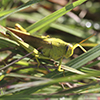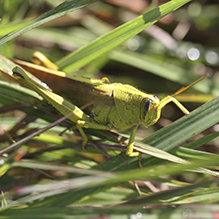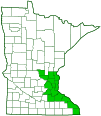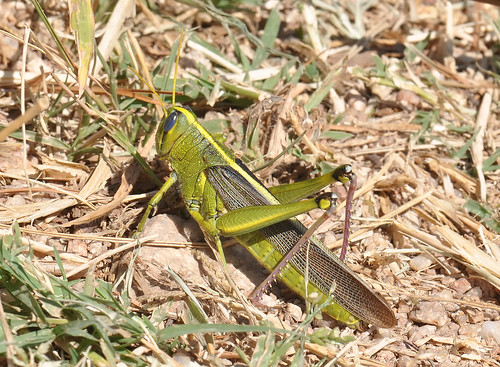spotted bird grasshopper
(Schistocerca lineata)
Conservation • Description • Habitat • Ecology • Distribution • Taxonomy
|
|
||||||||||||||
Description |
Spotted bird grasshopper is a common, medium-sized to large, short-horned grasshopper. It occurs in North America. Its exact distribution is in question. It is reported both in the historic literature and in recent online observations, in the United States from the East Coast to the West Coast, in Manitoba, Saskatchewan, and Alberta Canada, and in Baja California and Sonora Mexico. However, all reports from the eastern U.S. are believed by some to be based on confusion with other similar species. Spotted bird grasshopper adults are active from late spring to the first frost, June to October. They are found in tallgrass prairies, mixed-grass prairies, old fields, sand barrens, dunes, savannas, forest openings, weedy thickets, stream margins, and banks of ditches. They are abundant in dry, sandy, well-vegetated habitats, but they are also frequently found in moist habitats. The young (nymphs) feed on a single species, but adults feed on a variety of species. They feed mostly on legumes, especially wild licorice and leadplant, but also on alfalfa, beans, milkvetch, sweet clover, vetch, and wild pea. They have also been reported feeding on dandelion, oak, and wild rose. They feed very little on grasses. Spotted bird grasshopper is a highly variable species with four genetically distinct forms adapted to specific environmental conditions. Only one form, called the “typical” form, occurs in Minnesota. The description below refers to the typical form. Adult males are medium-sized, slender, and 1¼″ to 2″ (32 to 50 mm) in length. Females are much larger, more robust, and 1¾″ to 2¾″ (45 to 69 mm) in length. The body is reddish brown, often with a slight reddish-orange tinge. The head is medium sized, broad, and light brown to greenish brown. The eyes are striped vertically. There is a dark brown stripe extending downward from each eye. The upper part of the head (vertex) is narrow. The upper part of the forehead (fastigium) slopes downward. On each side of the fastigium, there is a shallow depression (foveola). The foveolae are very small to almost missing. The face is nearly vertical, only slightly slanted. The plate on the upper face (frontal costa) is relatively wide and flat. There are three small simple eyes (ocelli), one below each foveola and one near the middle of the costa. The antennae are medium length and yellow. There is a row of distinct black dots on the lateral margins of the frontal costa, and another row across the upper part of the plate on the face (clypeus). The upper plate on the first segment of the thorax (pronotum) is saddle shaped. The rear margin is broadly angled. The upper part is divided by a slightly raised but distinct longitudinal ridge (median carina). On the front part of the pronotum there are three transverse grooves that cut through the median carina. The sides of the pronotum are sparsely covered with light yellow dots (granules). Other than this, there are no stripes or other markings on the lateral lobes of the pronotum. The forewings (tegmina) are leathery, narrow and long. They extend well beyond the tip of the abdomen on the male, a little beyond on the female. They are light brown, and the veins are light brown. The hindwings have a slight yellowish tinge. There is usually a light yellow, longitudinal stripe extending from the vertex, across the pronotum, and almost to the tip of the tegmina. On the abdomen, the rear margin of each segment has a row of black dots. On the hind legs, the third segment (femur) is moderately slender. The upper surface is light brown. On the outer face, there is a row of black dots along the upper and lower margins. On the male, The femurs on the front and middle legs are highly inflated. On the female, they are not. The fourth segment (tibia) on the hind legs has some black, especially on the lower side. The spines on the tibia are yellow with a black tip. |
Size |
Male Total length: 1¼″ to 2″ (32 to 50 mm) Female Total length: 1¾″ to 2¾″ (45 to 69 mm) |
Similar Species |
Habitat |
Tallgrass prairies, mixed-grass prairies, old fields, sand barrens, dunes, savannas, forest openings, weedy thickets, stream margins, and banks of ditches |
Ecology |
Season |
June to October |
Behavior |
Adults are strong fliers, but they are mostly sedentary, spending their entire lifetime in the same habitat. When disturbed, they fly fast and for a long distance. They do not form large swarms. |
Life Cycle |
|
Nymph Food |
|
Adult Food |
Wild licorice, leadplant, alfalfa, beans, milkvetch, sweet clover, vetch, wild pea, dandelion, oak, and wild rose |
Distribution |
||
|
Sources Hebard, Morgan. (1932). The Orthoptera of Minnesota. University of Minnesota. Minnesota Agricultural Experiment Station. Retrieved from the University of Minnesota Digital Conservancy, https://hdl.handle.net/11299/204015. Haarstad, J. 1990. The Acrididae of Minnesota. Final report submitted to the Minnesota Department of Natural Resources. 28 pp. |
|
| 3/7/2024 | ||
Occurrence |
||
Common |
||
Taxonomy |
|
Order |
Orthoptera (grasshoppers, crickets, and katydids) |
Suborder |
Caelifera (grasshoppers, locusts, and allies) |
| Infraorder | Acrididea (grasshoppers) |
Superfamily |
Acridoidea (short-horned grasshoppers and locusts) |
Family |
Acrididae (short-horned grasshoppers) |
Subfamily |
Cyrtacanthacridinae |
Tribe |
Cyrtacanthacridini |
Genus |
Schistocerca (bird grasshoppers) |
Subordinate Taxa |
|
|
|
Synonyms |
|
Acridium emarginata Acridium emarginatum Schistocerca alutacea lineata Schistocerca alutaceum lineata Schistocerca emarginata Schistocerca scudderi Schistocerca venusta |
|
Common Names |
|
lined bird grasshopper plains bird grasshopper prairie bird-locust sand bird grasshopper spotted bird grasshopper spotted bird-locust |
|
Glossary
Clypeus
On insects, a hardened plate on the face above the upper lip (labrum).
Fastigium
On some insects, especially Orthoptera: the upper part of the forehead, between and often extending in front of the compound eyes.
Femur
On insects and arachnids, the third, largest, most robust segment of the leg, coming immediately before the tibia. On humans, the thigh bone.
Ocellus
Simple eye; an eye with a single lens. Plural: ocelli.
Pronotum
The exoskeletal plate on the upper side of the first segment of the thorax of an insect.
Tegmen
The modified, leathery front wing of grasshoppers and related insects that protects the hindwing. It may also serve as a camouflage, a defensive display, or a sound board. Plural: tegmina.
Tibia
The fourth segment of an insect leg, after the femur and before the tarsus (foot). The fifth segment of a spider leg or palp. Plural: tibiae.
Vertex
The upper surface of an insect’s head.
Visitor Photos |
||
Share your photo of this insect. |
||
This button not working for you? |
||
Babette Kis |
||
Schistocerca lineata (spotted bird grasshopper) Schistocerca lineata (spotted bird grasshopper), Chiwaukee Prairie, Sept. 5, 2021. |
||
MinnesotaSeasons.com Photos |
||
|
||
|
||

Visitor Videos |
||
Share your video of this insect. |
||
This button not working for you? |
||
|
Other Videos |
||
|

Visitor Sightings |
||
Report a sighting of this insect. |
||
This button not working for you? |
||
Babette Kis |
Location: Chiwaukee Prairie SNA, Kenosha Co., WI Schistocerca lineata (spotted bird grasshopper), Chiwaukee Prairie, Sept. 5, 2021. |
 |
MinnesotaSeasons.com Sightings |
||
|

|
Created: 3/7/2024 Last Updated: © MinnesotaSeasons.com. All rights reserved. |



